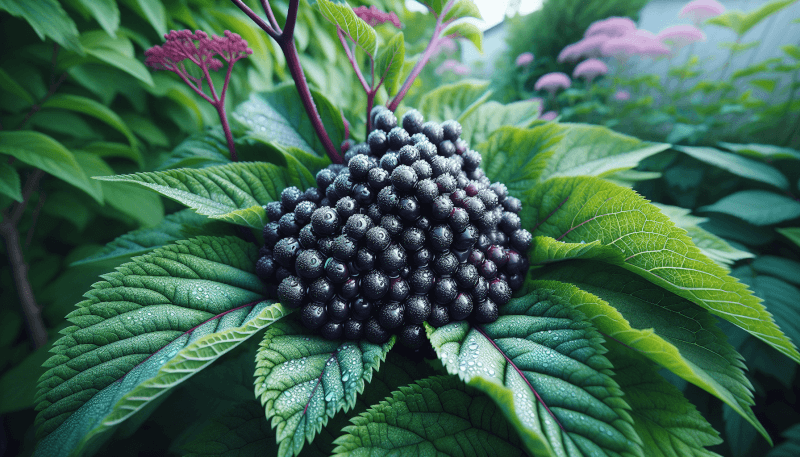As you embark on the journey of nurturing your own elderberry plant, it is essential to understand the key aspects of elderberry plant care. From choosing the perfect location to ensuring proper soil conditions and providing adequate water, this article will guide you through the essential steps in nurturing a healthy and thriving elderberry plant. With our expert tips and friendly advice, you will soon be enjoying the delightful fruits and ornamental beauty of this wonderful plant in your very own garden. So let’s get started on this exciting horticultural adventure!
Choosing and Planting Elderberry Bushes

Selecting the Right Variety of Elderberry
When choosing elderberry bushes for your garden, it is important to select the right variety that suits your specific needs. There are several different varieties of elderberries available, each with its own unique characteristics and growth requirements. Some varieties, such as the American Elderberry (Sambucus canadensis), are native to North America and are well-suited for the region’s climate. Other popular varieties include the European Elderberry (Sambucus nigra) and the Black Lace Elderberry (Sambucus nigra ‘Black Lace’), which are known for their ornamental value.
Consider factors such as climate, available space, and intended use when selecting an elderberry variety. For example, if you are looking to create an attractive focal point in your garden, a variety with striking foliage or flowers like the Black Lace Elderberry may be ideal. On the other hand, if you are primarily interested in harvesting the berries for culinary purposes, choosing a variety with a high berry yield, such as the American Elderberry, would be more suitable.
Choosing a Suitable Planting Site
Once you have chosen the elderberry variety that best suits your needs, it is crucial to select a suitable planting site. Elderberry bushes thrive in full sun but can tolerate partial shade. Ensure that the selected location receives at least six to eight hours of direct sunlight every day.
Take into consideration the soil conditions in the planting area. Elderberries prefer moist, well-drained soil that is slightly acidic. Avoid planting them in areas with heavy clay soil that tends to retain water and become waterlogged. If your soil is clayey, you can improve drainage by amending it with organic matter, such as compost or well-rotted manure.
It is also important to check the available space before planting elderberries. These bushes can reach a height and width of 6 to 12 feet, so make sure you allocate enough room for their mature size. Additionally, keep in mind that elderberry bushes are typically multi-stemmed, so plan for sufficient space between plants for proper air circulation.
Preparing the Soil for Planting
Before planting elderberry bushes, it is essential to prepare the soil to create a favorable growing environment. Start by removing any weeds or grass from the planting area. Clearing the area of competing vegetation will eliminate competition for nutrients and reduce the risk of pest and disease issues.
Once the area is cleared, loosen the soil to a depth of at least 12 inches. This will promote healthy root development and improve drainage. You can use a garden fork or a tiller to work the soil. Incorporating organic matter, such as compost or well-rotted manure, into the soil will also enhance its fertility and moisture-holding capacity.
Planting Elderberry Bushes
When the soil is adequately prepared, it’s time to plant your elderberry bushes. Dig a hole that is slightly larger and deeper than the root ball of the plant. Place the root ball in the hole and backfill with soil, gently firming it around the roots. Be careful not to bury the plant too deeply; the top of the root ball should be level with or slightly above the soil surface.
Spacing between elderberry plants should be about 6 to 10 feet, depending on the variety and desired growth habit. This will allow enough room for the plants to spread and receive ample sunlight and airflow.
After planting, water the bushes thoroughly to settle the soil and eliminate any air pockets around the roots. Adding a layer of mulch around the base of the plants will help conserve moisture, suppress weeds, and moderate soil temperature.
Watering Requirements for Newly Planted Elderberry Bushes
Newly planted elderberry bushes require regular watering to establish themselves and promote healthy root growth. Water the plants deeply after planting and continue to water them regularly for the first few weeks. Aim to keep the soil consistently moist but not waterlogged.
Monitor the moisture level in the soil by sticking your finger about an inch into the soil. If it feels dry at that depth, it’s time to water. Be mindful of fluctuations in rainfall and adjust watering accordingly. Avoid overwatering, as this can lead to root rot and other fungal diseases.
As the plants become established, their watering needs will decrease. Once the roots have grown deeper into the soil, they will be better equipped to access moisture from the surrounding environment. However, during periods of prolonged drought, it is still important to provide supplemental irrigation to keep the elderberry bushes healthy and productive.

